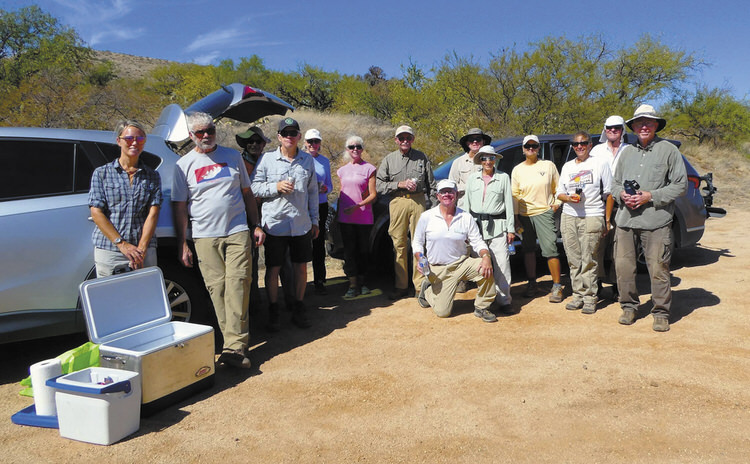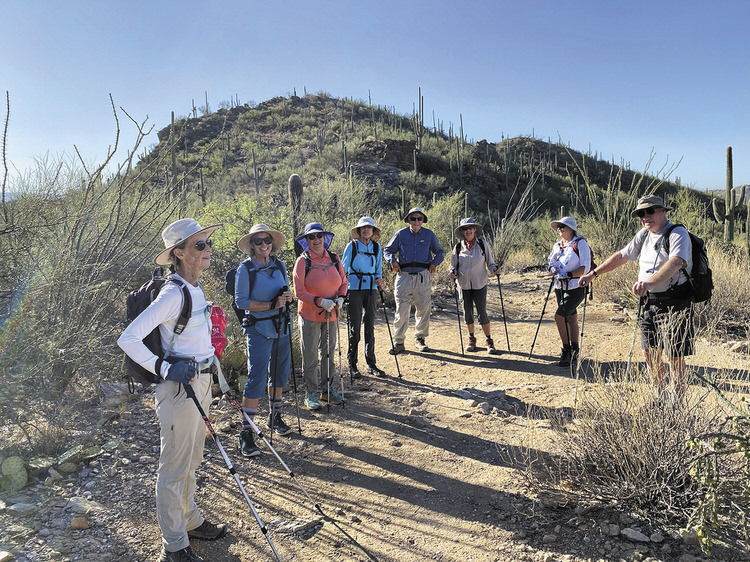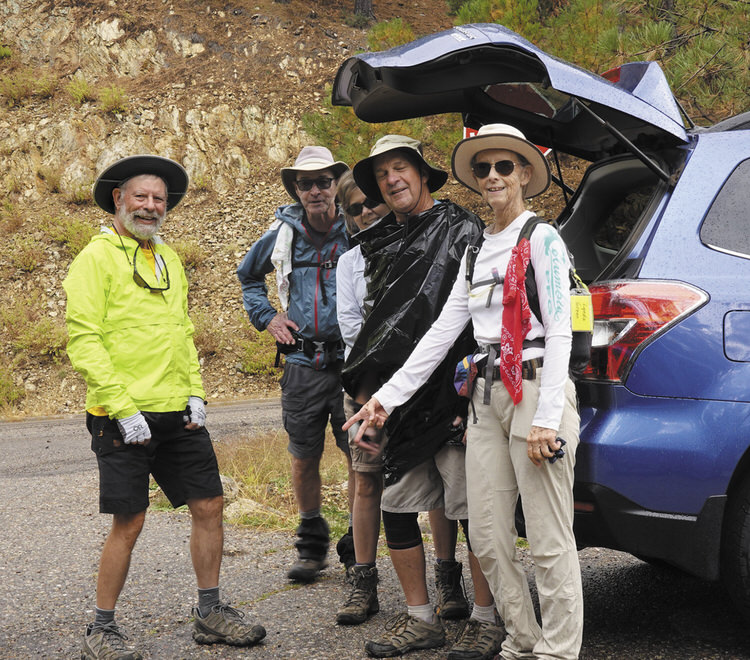
Chrissy Fitcher from ATA (far left) and Ray Peale (under the shade of the car tailgate) refresh with the crew after their labor. (Photo by Josh from ATA)
Hiking Club Tackles Trail Maintenance
Lori Anderson
A dozen members of the SaddleBrooke Hiking Club were joined by volunteers for the Arizona Trail Association (ATA) for fun in the sun on Oct. 18. Club member Ray Peale is the Steward for Oracle Passage #13 of the Arizona Trail, and their task was to work on the section of this passage between South Mount Lemmon Road and Webb Road. Ray from the SaddleBrooke Hiking Club and Chrissy Fitcher from the ATA led the team.
The ATA provided hard hats, gloves, and tools. Following a safety briefing, part of the group worked with Ray to improve drainage along the trail in order to reduce erosion, and the rest of the group spread out along the trail to brave what has been affectionately dubbed “Catclaw Alley” to widen the trail by removing catclaw and other vegetation. As we fought the catclaw, cutting it back and digging up the roots, twigs cut from the plants grabbed onto pant legs and sleeves in a desperate attempt to remain in place. The maintenance crew typically won.
Battle-scarred and spent after toiling in the desert sun, the crew gathered back at their vehicles for a well-deserved reward of tasty treats and beverages, satisfied by a job well done.
Trail maintenance is scheduled for the third Wednesday of each month (except December) from now through March. The next work day will be Nov. 15. If interested in joining the crew, please email Lori Anderson at msalaa19@gmail.com or Ray Peale at ray.peale@gmail.com.

Hikers pause along the trail. (Photo by Bruce Landeck)
Esperero and Rattlesnake Canyons Offer Contrasts
Lynda Green
Sabino Canyon Recreation Area contains many trails of differing levels of difficulty for SaddleBrooke Hiking Club members. On Oct. 4, a group of nine hikers met for a relatively easy “walk in the park,” which consisted of tacking the Bluff and Rattlesnake Canyon Trails onto the Esperero Canyon Trail. Guide Bruce Landeck wisely moved the starting time from 8 a.m. to an early 7 a.m. to avoid the heat, for much of the way proceeds through open desert packed with saguaro cacti and low-growth trees and plants.
The first leg started level and then climbed a rocky, but not too onerous, path where views of the Santa Catalina Range grew enormous in front. Next, the Rattlesnake Trail dipped back down into its own dry creek. Here, the hikers found more shade and, thankfully, no rattlesnakes. In the side of a stony outcropping, which rose to the right, Landeck pointed out a small cave reputed to be the domicile of, perhaps, a mountain lion. If so, the creature was either sleeping or not at home.
Continuing on, this trail met Sabino’s tram road, peopled with walkers, a few runners, and, finally, the morning’s first tram. After a short stint on the pavement, hikers found their next leg, the Bluff Trail. This piece wound down the rocks with only one or two huge steps to a shady stopping place beneath Sabino Dam. When water flows, this site offers a cool respite with the welcome sound of running water—sometimes rushing precipitously. On this day, however, the stones of the dam, built in the 1930s, sat bone dry. Nevertheless, this condition provided an interesting view of the dam’s structure.
The remainder of the outing consisted of a simple, mostly flat walk back to the Visitor Center and parking lot. By then the temperature hovered near 80 degrees, which, said Landeck, was precisely where he likes to end his hikes.

Hikers (left to right): Linda Linegar, Ruth Leman, Georgette Brown, Mary Kopp, Maria Szentirmai, Alex Infald, Katie Atkins, Bill Brown, Terry Hughes (photo by Bruce Landeck)
Dripping Springs from Sutherland Trail
Terry Hughes
After brief introductions at the Catalina State Park trailhead on Sept. 18, SaddleBrooke hikers began their trek with the temperature hovering around 70 degrees. The sky was another cloudless Arizona blue. In short order, they crossed one of the many dry washes found in the park during the dry season.
Within the first mile or so, guide Bruce Landeck pointed out one of the more interesting crested saguaros found in the Tucson area. Rather than having the crest formed at the tip of the saguaro arm, this example had grown the crest in the center of the cactus. This photo-op of the crested saguaro gave a great opportunity to take a water break before continuing on to Dripping Springs.
Shortly after leaving the park boundary, hikers veered right toward the Catalinas and the Springs. It was clear that the trail had gotten very overgrown. However, another hike guide, Terry McCarthy, had spent significant time clearing the overgrowth. Along the trail was ample evidence of McCarthy’s hard work, which prevented hikers from suffering many scratches.
Once the group reached Dripping Springs, they stopped for a delightful snack break in the shade at the base of the Catalinas. On the return trip to the trailhead, Landeck pointed out several grinding holes, worn with use by early Native Americans in their food preparation. Archeologists believe that these grinding holes, carved into bedrock, were used to grind mesquite and palo verde beans into flour.

Hikers model rain gear (or lack thereof). (Photo by Bruce Hale)
Mountain Weather Shortens a Hike
Lynda Green
Oct. 17 dawned bright and clear, and weather apps promised a fair day in relatively cool weather for the five hikers from SaddleBrooke who signed up for this welcome venture. Box Camp, near the top of Mount Lemmon, offers a nice, 5.5-mile trek down a long slope to a clear, rocky overlook where hikers can find prominent Sabino Canyon features down below.
This day, the hiking guide was guide-in-training Cathy Meyer, mentored by veteran guide Tim Butler. Bruce Hale, Tom Conrad, and Lynda Green completed the group. Although not yet dressed for fall, the woods gave touches of colors here and there to suggest that fall had begun. The skies above showed some white, puffy clouds, along with brilliant blue.
Halfway down to the overlook, the trail winds back and forth along a dry creek bed. Within a mile of the destination, however, Meyer paused to claim that she heard thunder. “No,” the others argued, “must have been a plane overhead.” But soon, Meyer stopped again. “Thunder,” she said. And before anyone could offer another denial—rumble! Undeniably thunder.
A brief discussion convinced the group that, a mountain being a bad place to experience lightning, an immediate reverse of the hike was in order. Soon, a light rain began, and then it became harder. Those who had thought to stick raingear in their packs stopped to don it. Conrad borrowed an “emergency raincoat,” i.e., a garbage bag, from Butler, while Green and Meyer simply endured the wetness.
Driving back down the mountain, the weather cleared miraculously. Green, Meyer, and Conrad wondered what all the people heading up the mountain were going to decide once they discovered the conditions. Hale and Butler, in the “TNT Truck,” must have headed for the Cookie Shack, because they were not seen again.
